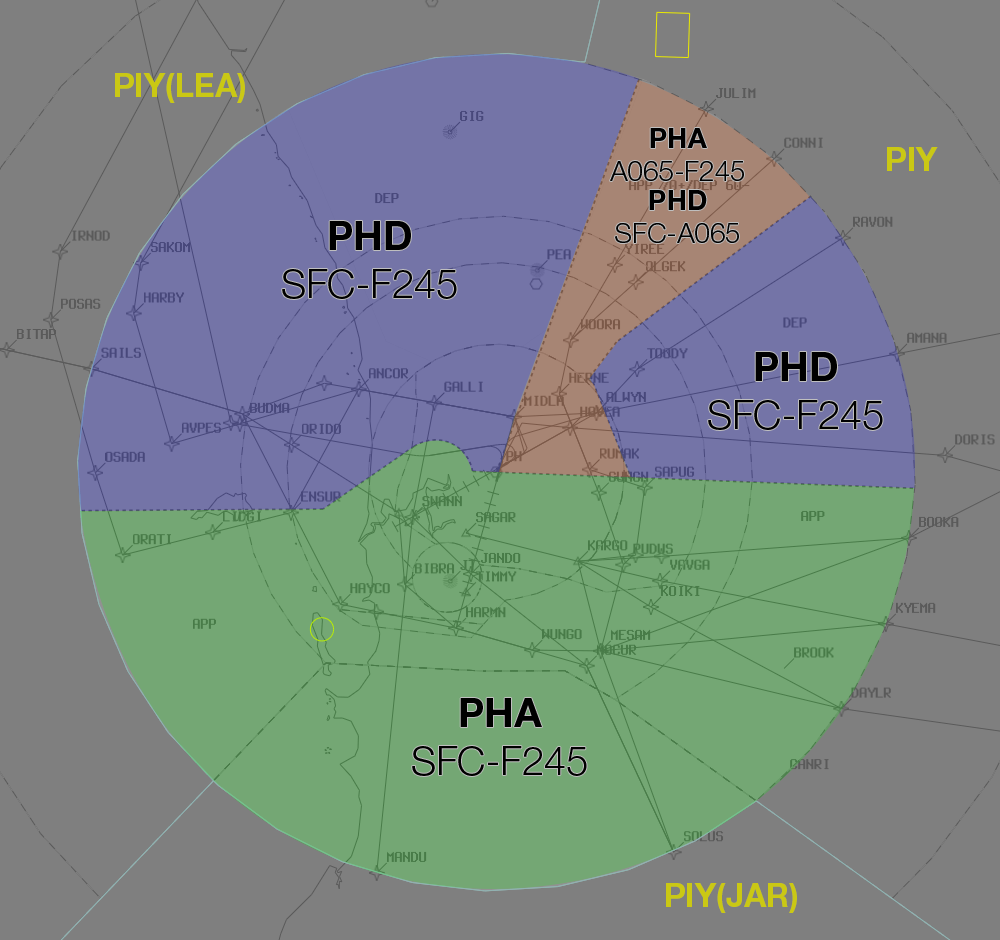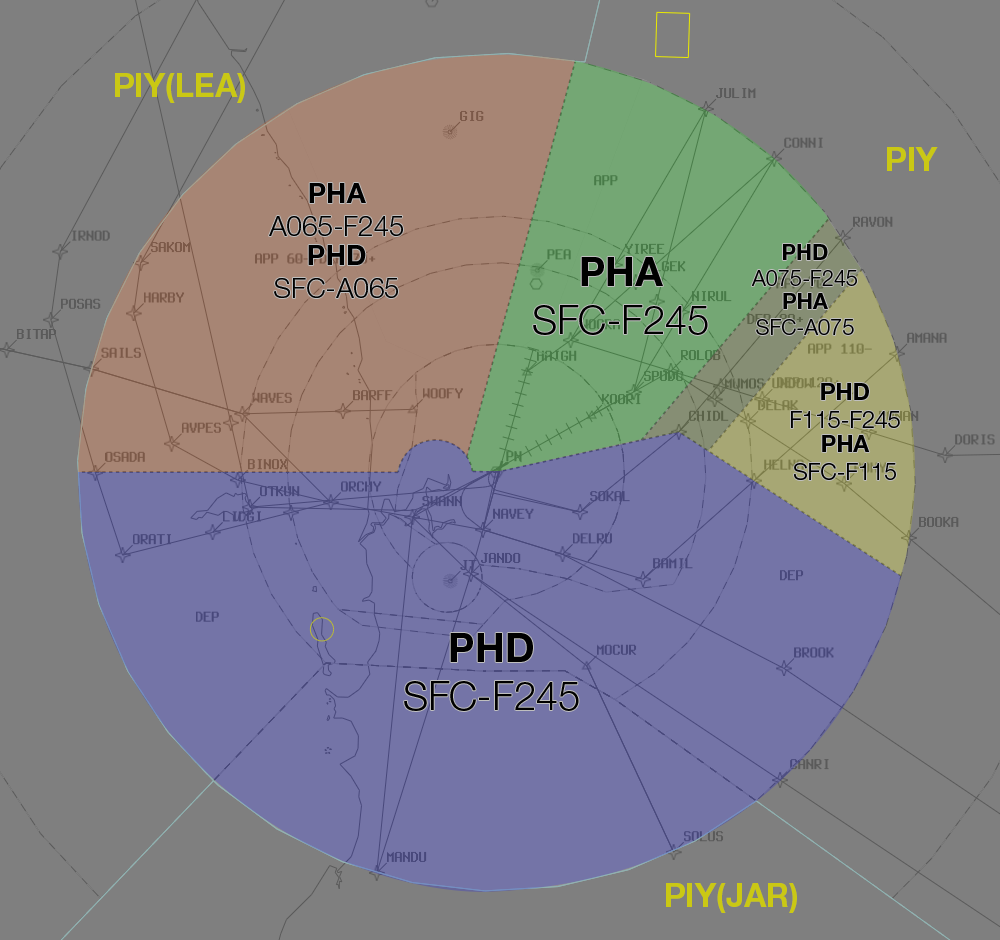Perth TCU
| Name | ID | Callsign | Frequency | Login Identifier |
|---|---|---|---|---|
| Perth Approach | PHA | Perth Approach | 123.600 | PH_APP |
| Perth Departures† | PHD | Perth Departures | 118.700 | PH_DEP |
| Perth Flow† | PFL | PH_FMP |
† Non-standard positions may only be used in accordance with VATPAC Air Traffic Services Policy
Airspace
The PH TCU is responsible for the airspace within 36 DME of the PH VOR, SFC to F245.
Note
A significant portion of the TMA airspace south of the PH VOR (roughly 20 DME onwards) is classified Class E with a lower limit of F125. RPT aircraft frequently enter/exit the TMA via this airspace, see Departure Procedures for more info.
When PEA TCU is online R155A & B is released to them from A020 to F160. When R155A is active to F160, PH TCU airspace above R155A shall be released to PEA TCU.
Reclassifications
JT CTR
JT CTR reverts to Class G when JT ADC is offline, and is administered by the relevant PH TCU controller.
See also: JT ADC Offline.
Airspace Division
The divisions of the airspace between PHA, and PHD change based on the Runway Mode.
Note
The following diagrams do not include non PH TCU areas of responsibility such as JT CTR or PEA APP
03/06

21/24

Runway Modes
Generally, YPPH operates on either the Southwest or Northeast runway plan, as below. Where strong winds dictate the use of only a single runway, this shall be nominated in the ATIS.
Southwest Plan
With the Southwest Plan active, all departures shall be assigned runway 21 by PH ACD. Arrivals shall be processed to either runway 21 or 24 based on their feeder fix, as per the table below:
| Feeder Fix | Assigned Runway |
|---|---|
| JULIM | 21 |
| SAPKO | 21 |
| IPMOR | 21 |
| BEVLY | 24 (or 21 if operationally required) |
| GRENE | 24 |
| SOLUS | 24 |
Northeast Plan
With the Northeast Plan active, departures via AVNEX, OTLED, MANDU, SOLUS, and OPEGA shall be assigned runway 03 by PH ACD. All other departures shall be assigned runway 06. All arrivals shall be processed to runway 03.
Scenic Flights
VFR aircraft may plan to conduct scenic flights within CTA in the PH TMA. A number of VFR routes exist to facilitate this, including:
| Name | Route | Preferred Altitude |
|---|---|---|
| Victor 65 | CTE-PCTY-HKE |
At or below A015 |
| Victor 66 | TLMI-HRR-CDM |
At or below A035 |
Other levels are available at the discretion of the TCU controller but coordination may be required if adjacent TMA sectors are online. See TCU Internal for coordination requirements.
Aircraft wishing to conduct a scenic flight over the Perth CBD should be cleared via the Victor 65 route. No lateral separation standard exists between Victor 65 and the extended centreline of runway 06/24, so controllers must ensure that an alternative form of separation assurance exists.
Example
VH-CYF: "Perth Approach, CYF, Cessna 172, overhead FREM, 1,500ft, received Bravo, request Victor 65"
PHA: "CYF, squawk 0542, remain clear of class C airspace"
VH-CYF: "Squawk 0542, remain OCTA, CYF"
When clearance (reference traffic into/out of YPPH) is available:
PHA: "CYF, cleared Victor 65, maintain 1,500ft"
VH-CYF: "Cleared Victor 65, maintain 1,500ft, CYF"
Aircraft departing YPPH and intending to conduct the Victor 65 route will be coordinated by PH ACD. See Airways Clearances.
Arrival Procedures
YPJT Arrivals
IFR RNAV equipped arrivals to Jandakot planned via a fix listed shall be cleared via STAR dependent on Perth active runway:
| Perth Active Runway | 03/06 | 21/24 |
|---|---|---|
| North JULIM (Jet) SAPKO (Non-Jet) |
JT 2G / WOORA |
DCT JT |
| East BEVLY (Jet) GRENE (Non-Jet) HAMTN (Non-Jet) |
JT 2G / BEVLY JT 2G / GRENE JT 2W / HAMTN |
JT 2R / BEVLY JT 2R / GRENE N/A |
YPEA Arrivals
Reserved
JT/PEA ADC Offline
Due to the low level of CTA at these aerodromes, it is best practice to give airways clearance to aircraft at the holding point, to ensure departing aircraft can have uninterrupted climb.
Example
AAC: "Perth Approach, AAC, PC12, POB 8, IFR, Taxiing YPJT for YPKG, Runway 06L"
PHA: "AAC, Perth Approach, Squawk 3601, No Reported IFR Traffic, Report Ready at the Holding Point for Airways Clearance"
AAC: "Squawk 3601, Wilco, AAC"
AAC: "AAC, Ready Runway 06L, Request clearance"
PHA: "AAC, Cleared to YPKG via PH, Flight Planned Route. Make Visual Right turn DCT PH, Climb to A040"
AAC: "Cleared to YPKG via PH, Flight Planned Route. Make Visual Right turn DCT PH, Climb to A040, AAC"
Departure Procedures
Aircraft departing the TMA to the south planned at F130 or above will likely leave and re-enter CTA on climb. These aircraft should be instructed to leave and re-enter on climb to the standard assignable level (or other level as appropriate).
Example
PHD: "RXA2125, leave and re-enter controlled airspace on climb to F180, no reported IFR traffic"
RXA2125: "Leave and re-enter controlled airspace on climb to F180, RXA2125"
Coordination
Enroute
Departures
Voiceless for all aircraft:
- Tracking via a Procedural SID terminus; and
- Assigned the lower of
F180or theRFL
All other aircraft going to PIY CTA must be Heads-up Coordinated by PH TCU prior to the boundary.
Example
PH TCU -> PIY: "PFY9916, with your concurrence, will be assigned F130, for my separation with JTE654"
PIY -> PH TCU: "PFY9916, concur F130"
Arrivals
Voiceless for all aircraft:
- With ADES YPPH; and
- Assigned a STAR; and
- Assigned
A090
All other aircraft coming from PIY CTA will be Heads-up Coordinated to PH TCU.
PH ADC
Auto Release
'Next' coordination is not required for aircraft that are:
a) Departing from a runway nominated on the ATIS; and
b) Assigned the standard assignable level; and
c) Assigned a Procedural SID
All other aircraft require a 'Next' call to PH TCU.
Example
PH ADC -> PH TCU: "Next, ABC, runway 03"
PH TCU -> PH ADC: "ABC, Heading 010, unrestricted"
PH ADC -> PH TCU: "Heading 010, ABC"
PH ADC: "ABC, Assigned heading left 010, Runway 03, Cleared for Takeoff"
ABC: "Left heading 010, Runway 010, Cleared for Takeoff, ABC"
The PH TCU controller can suspend/resume Auto Release at any time, with the concurrence of PH ADC.
The Standard Assignable level from PH ADC to PH TCU is the lower of A050 or the RFL.
Airways Clearances
The controller assuming responsibility of ACD shall give heads-up coordination to the relevant PH TCU controller prior to the issue of the following clearances:
a) VFR Departures
b) Aircraft using a runway not on the ATIS
Example
PH ACD -> PH TCU: "ABC, requesting Victor 65"
PH TCU -> PH ACD: "ABC, cleared Victor 65, 1,500ft"
PH ACD -> PH TCU: "Cleared Victor 65, 1,500ft, ABC"
PH TCU Internal
Voiceless coordination is in place for all aircraft processed by the Victor 65 and 66 routes in accordance with the table below.
| Route | Non-Coordination Levels | Label Data |
|---|---|---|
| Victor 65 | At or below A015 |
V65 |
| Victor 66 | At or below A035 |
V66 |
Other levels are available at the discretion of the TCU controller but coordination may be required if adjacent TMA sectors are online.
All other aircraft transiting between internal PH TCU boundaries must be heads-up coordinated.
Example
PHA -> PHD: "via PH, FD123"
PHD -> PHA: "FD123, A090"
JT ADC
Airspace
JT ADC is responsible for the Class D airspace in the JT CTR SFC to A015.
Refer to Reclassifications for operations when JT ADC is offline.
Departures
When the aircraft is ready for departure, JT ADC will coordinate with the relevant PH TCU controller above them for permission to release the aircraft into their CTA.
Example
JT ADC -> PH TCU: "Next, FD420, runway 24R"
PH TCU -> JT ADC: "FD420, Unrestricted"
JT ADC -> PH TCU: "FD420"
The Standard Assignable level from JT ADC to PH TCU is the lower of A030 or the RFL, any other level must be prior coordinated.
Arrivals/Overfliers
PH TCU will heads-up coordinate arrivals/overfliers from Class C to JT ADC prior to 5 mins from the boundary.
IFR aircraft will be cleared for the coordinated approach (Instrument or Visual) prior to handoff to JT ADC, unless JT ADC nominates a restriction.
VFR aircraft require a level readback.
Example
PH TCU -> JT ADC: "via RNAV-Z RWY 06L, FD416, circling to land RWY 24R"
JT ADC -> PH TCU: "FD416, RNAV-Z RWY 06L with a circle to land RWY 24R"
PEA ADC
Reserved.